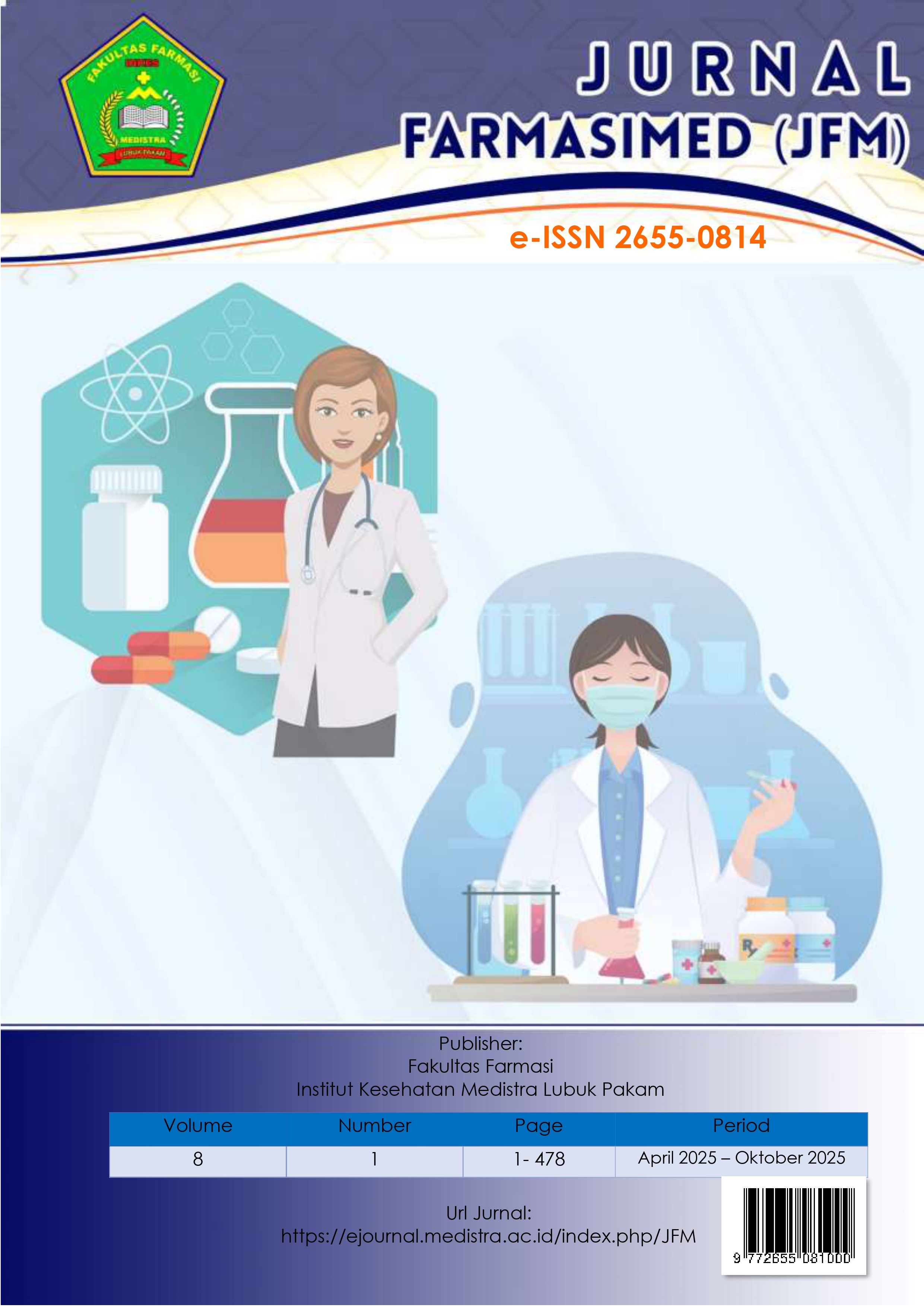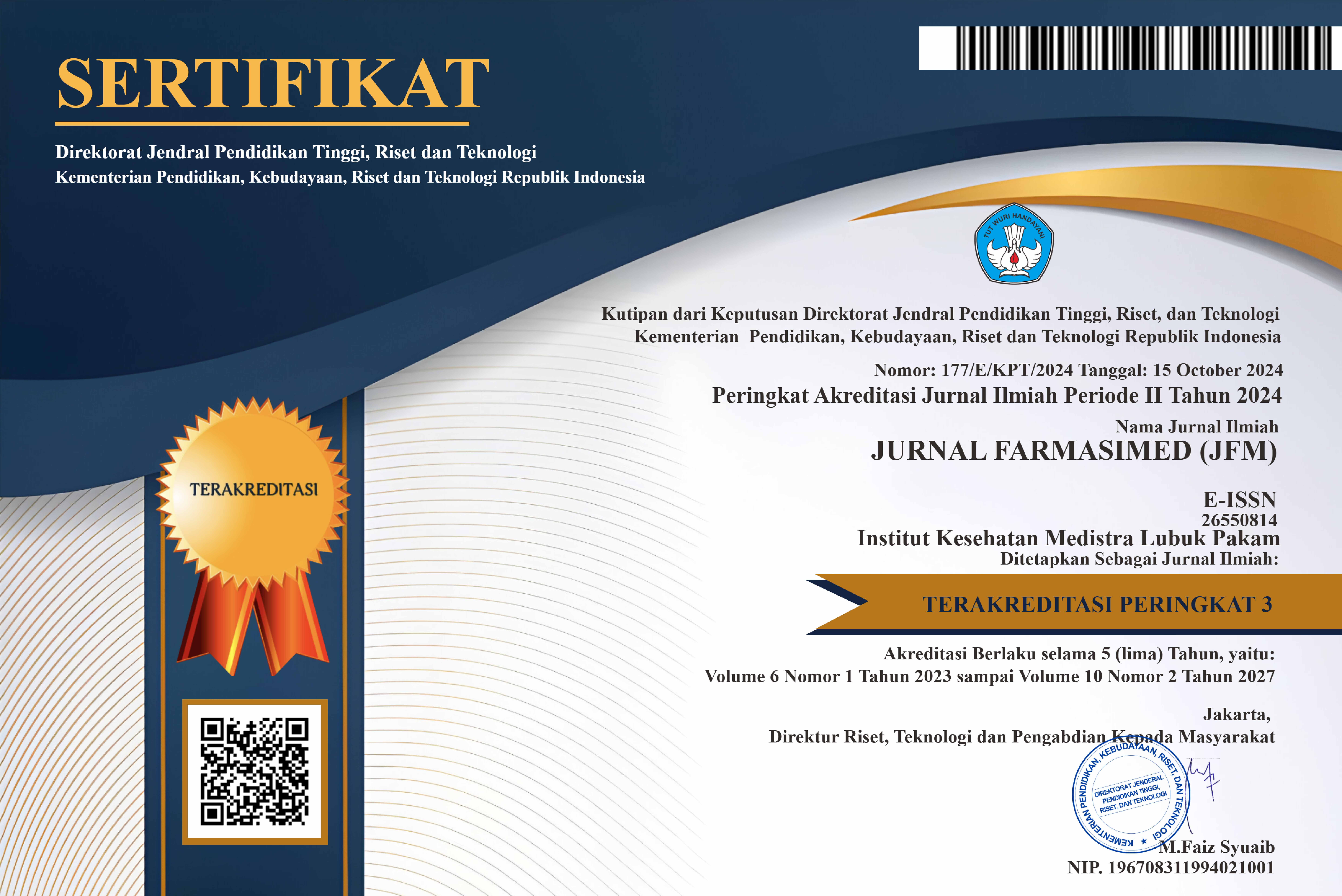Rationality Analysis of Antibiotic Use in Chronic Kidney Disease Patients at Dr. R. Sosodoro Djatikoesoemo Regional HospitalUsing the Gyssens Method
DOI:
https://doi.org/10.35451/6xrbg306Keywords:
Rational use of antibiotics, Chronic Kidney Disease, Gyssens MethodAbstract
Chronic kidney disease (CKD) requires special attention in antibiotic therapy due to pharmacokinetic changes that can affect drug concentration and efficacy. Inappropriate antibiotic selection or dosing may increase toxicity risk and further impair renal function. This study aimed to analyze the rationality of antibiotic use in CKD patients in the internal medicine ward of Dr. R. Sosodoro Djatikoesoemo Regional Hospital, Bojonegoro. A retrospective design was used, analyzing patient medical records from July to December 2024. The rationality of antibiotic use was assessed using the Gyssens method, which evaluates the appropriateness of indication, dosage, interval, duration, and antibiotic selection. Among 91 patients, the largest age group was 45–55 years (26.37%), with a hospital stay of 1–3 days (51.65%). The most frequently used antibiotics were ceftriaxone (43.96%) and cefepime (32.97%). The Gyssens analysis showed that 63.74% of antibiotic use was rational (category 0), while 36.26% was irrational, with the most common issue being category IVd (availability of a narrower-spectrum alternative) at 37.36%. Although most antibiotic use complied with clinical guidelines, there remains a need for improvement in selecting antibiotics with a more appropriate spectrum. Strengthening antibiotic stewardship programs is expected to improve therapeutic outcomes, minimize toxicity risks, and prevent antimicrobial resistance in hospital settings.
Downloads
References
[1] A. Inayati, U. Hasanah, S. Maryuni, A. Dharma, dan W. Metro, “Dukungan Keluarga dengan Kualitas Hidup Pasien Gagal Ginjal Kronik yang Menjalani Hemodialisa di RSUD Ahmad Yani Metro,” J. Wacana Kesehat., vol. 5, no. 2, hal. 588, 2021.
[2] C. P. Kovesdy, “Epidemiology of chronic kidney disease: an update 2022,” Kidney International Supplements, vol. 12, no. 1. Elsevier B.V., hal. 7–11, Apr 01, 2022, doi: 10.1016/j.kisu.2021.11.003.
[3] E. Syahputra et al., “Dukungan Keluarga Berhubungan Dengan Kualitas Hidup Pasien Gagal Ginjal Kronik yang Menjalani Terapi Hemodialisa,” 2022. [Daring]. Tersedia pada: http://jurnal.globalhealthsciencegroup.com/index.php/JPPP.
[4] Kemenkes RI, Laporan Riskesdas 2018 Nasional. 2018.
[5] T. Liyanage et al., “Prevalence of Chronic Kidney Disease in Asia: A Systematic Review and Analysis,” BMJ Glob. Heal., vol. 7, no. 1, Jan 2022, doi: 10.1136/bmjgh-2021-007525.
[6] S. Tansri dan Rahmi Makmur, “Tingkat Pengetahuan Orang Tua Terhadap Penggunaan Antibiotika pada Anak,” J. Kesehat. Yamasi Makassar, vol. 8, no. 1, hal. 117–128, 2024, doi: 10.59060/jurkes.v8i1.318.
[7] Kemenkes RI, “Peraturan Menteri Kesehatan Republik Indonesia Nomor 28 Tahun 2021 Tentang Pedoman Penggunaan Antibiotik,” no. 217, 2021.
[8] G. Mandey, R. Tampa’i, R. V Sakul, Y. K. Lengkey, dan E. Z. Karundeng, “Evaluasi Kerasionalan Penggunaan Antibiotik Pada Pasien Gagal Ginjal Di Rumah Sakit Siloam Manado,” Trop. J. Biopharm., no. 1, hal. 31–38, 2020.
[9] Kidney Disease: Improving Global Outcomes (KDIGO) CKD Work Group. KDIGO 2024, “Clinical Practice Guideline for the Evaluation and Management of Chronic Kidney Disease,” Kidney Int., vol. 105, no. 4, hal. A1, Apr 2024, doi: 10.1016/s0085-2538(24)00110-8.
[10] R. K. Saputri, T. A. Hutahaen, D. I. Pramesti, dan N. Farlina, “Sosialisasi Dan Pelatihan Dagusibu Obat Sebagai Upaya Pencegahan Pengobatan yang Tidak Rasional di Masa Pandemi COVID 19,” Bul. Udayana Mengabdi, vol. 22, no. 4, hal. 223, 2023.
[11] R. Belinda, A. Subarnas, dan I. Mutiara, “Rasional Penggunaan Antibiotik Menggunakan Metode Gyssens pada Pasien Poli Bedah Mulut,” Farmaka, vol. 20, no. 2, hal. 53–59, 2021.
[12] W. Anggraini, T. M. Candra, S. Maimunah, dan H. Sugihantoro, “Evaluasi Kualitatif Penggunaan Antibiotik pada Pasien Infeksi Saluran Kemih dengan Metode Gyssens,” KELUWIH J. Kesehat. dan Kedokt., vol. 2, no. 1, hal. 1–8, Des 2020, doi: 10.24123/kesdok.v2i1.2876.
[13] B. P. Dewi, A. A. Darussalam, Y. Rimbawati, dan S. W. Safitri, “Hubungan Karakteristik Pasien Usia Lanjut Dengan Penyakit Ginjal Kronik (PGK) Yang Menjalani Hemodialisis Disebabkan Diabetes Melitus Dan Hipertensi,” J. Kesehat. Terap., vol. 9, no. 2, hal. 37–46, Jul 2022, doi: 10.54816/jk.v9i2.537.
[14] G. Alfano et al., “Rethinking Chronic Kidney Disease in the Aging Population,” Life, vol. 12, no. 11. MDPI, Nov 01, 2022, doi: 10.3390/life12111724.
[15] Arianti, A. R, dan E. M, “Karakteristik Faktor Risiko Pasien Chronic Kidney Disease (CKD) Yang Menjalani Hemodialisa Di RS X Madiun,” Biomedika, vol. 12, no. 1, hal. 36–43, 2020, doi: 10.23917/biomedika.v12i1.9597.
[16] L. Xu, C. Yu, A. Chen, C. Li, dan Y. Mao, “Longitudinal Analysis of Renal Function Changes in Elderly Populations: Health Status Evaluation and Risk Factor Assessment,” Clin. Interv. Aging, vol. 19, no. May, hal. 1217–1224, 2024, doi: 10.2147/CIA.S450388.
[17] F. R. Fadhilah dan I. Dhamanti, “Literature Review: Analisis Faktor yang Mempengaruhi Length Of Stay pada Pasien IGD Di Rumah Sakit,” J. Public Heal. Innov., vol. 4, no. 02, hal. 263–271, Jun 2024, doi: 10.34305/jphi.v4i02.1138.
[18] K. Stone, R. Zwiggelaar, P. Jones, dan N. Mac Parthaláin, “A Systematic Review of The Prediction of Hospital Length of Stay: Towards A Unified Framework,” PLOS Digit. Heal., vol. 1, no. 4 April, Apr 2022, doi: 10.1371/journal.pdig.0000017.
[19] M. R. Karizki, I. Puspitasari, dan R. H. Asdie, “Rasionalitas Penggunaan Antibiotik Empirik dan Definitif pada Pasien Sepsis di Intensive Care Unit RSUP. Dr. Sardjito,” Maj. Farm., vol. 17, no. 3, hal. 343–354, 2021, doi: 10.22146/farmaseutik.v1i1.62045.
[20] M. Yusuf, N. Auliah, dan H. E. Sarambu, “Gyssens pada Pasien Pneumonia di Rumah Sakit Bhayangkara Kupang Periode Evaluation of Antibiotic Usage With Gyssens Method in Pneumonia Patients in Bhayangkara Hospital Kupang Period July – December 2019,” J. Ris. Kefarmasian Indones., vol. 4, no. 2, hal. 215–229, 2022.
[21] C. J. Kristianti et al., “Evaluasi Rasionalitas Penggunaan Antibiotik pada Neonatus dengan Infeksi Pneumonia Menggunakan Metode Gyssens di Rumah Sakit X Kota Bandung,” Indones. J. Pharm. Educ., vol. 3, no. 3, hal. 2775–3670, 2023, doi: 10.37311/ijpe.v3i3.22370.
[22] S. D. Rohmah, R. Andrajati, dan L. T. Yudhorini, “Qualitative Evaluation of Antibiotic Use in Bacterial Meningitis Patients using the Gyssens Method,” J. Aisyah J. Ilmu Kesehat., vol. 8, no. S1, hal. 169–178, 2023, doi: 10.30604/jika.v8is1.1693.
[23] J. Liu et al., “Rationality of Time-Dependent Antimicrobial Use in Intensive Care Units in China: A Nationwide Cross-Sectional Survey,” Front. Med., vol. 8, no. February, hal. 1–12, 2021, doi: 10.3389/fmed.2021.584813.
[24] Fadrian, Antibiotik, Infeksi Dan Resistensi. Padang: Universitas Andalas Press, 2023.
[25] B. Aloy et al., “Antibiotics And Chronic Kidney Disease: Dose Adjustment Update for Infectious Disease Clinical Practice,” Medecine et Maladies Infectieuses, vol. 50, no. 4. Elsevier Masson SAS, hal. 323–331, Jun 01, 2020, doi: 10.1016/j.medmal.2019.06.010.
[26] F. Alasmari, M. S. Alasmari, H. M. Muwainea, dan H. A. Alomar, “Physiologically-Based Pharmacokinetic Modeling For Single and Multiple Dosing Regimens of Ceftriaxone In Healthy And Chronic Kidney Disease Populations : A Tool For Model-Informed Precision Dosing,” Front. Pharmacol., no. July, hal. 1–14, 2023, doi: 10.3389/fphar.2023.1200828.
[27] Y. Oyama, Y. Iwafuchi, dan I. Narita, “Ceftriaxone-Associated Pseudolithiasis in Hemodialysis Patients: A Case Series Study,” Ren. Replace. Ther., vol. 7, no. 1, hal. 1–8, 2021, doi: 10.1186/s41100-021-00320-4.
[28] Z. Alagha, S. Crow, A. M. Z. Abdeen, M. Alastal, dan A. Alastal, “Cefepime Neurotoxicity in Patients With Normal Renal Function: An Overlooked Cause of Encephalopathy in the Intensive Care Unit,” J. Investig. Med. High Impact Case Reports, vol. 12, hal. 1–5, 2024, doi: 10.1177/23247096241259534.
[29] G. M. Pais et al., “Clinical Pharmacokinetics and Pharmacodynamics of Cefepime,” Clin. Pharmacokinet., vol. 61, no. 7, hal. 929–953, 2022, doi: 10.1007/s40262-022-01137-y.
[30] T. H. Hendyatama dan N. Mardiana, “Calculation of Drug Dosage In Chronic Kidney Disease,” Curr. Intern. Med. Res. Pract. Surabaya J., vol. 1, no. 1, hal. 21, 2020, doi: 10.20473/cimrj.v1i1.16894.
[31] L. F. Valladales-Restrepo et al., “Use of antibiotics in patients with chronic kidney disease: evidence from the real world,” Expert Opin. Drug Saf., 2024, doi: 10.1080/14740338.2024.2443780.
[32] Kemenkes RI, Panduan Penatagunaan Antimikroba di Rumah Sakit. 2020.
[33] R. Hassanpour et al., “Evaluation of pharmacokinetic and pharmacodynamic parameters of meropenem in critically ill patients with acute kidney disease,” Eur. J. Clin. Pharmacol., vol. 77, no. 6, hal. 831–840, 2021, doi: 10.1007/s00228-020-03062-0.
[34] T. Hu, Y. Sun, dan Z. An, “Dose- and time-dependent manners of moxifloxacin induced liver injury by targeted metabolomics study,” Front. Pharmacol., vol. 13, no. September, hal. 1–15, 2022, doi: 10.3389/fphar.2022.994821.
[35] Queensland Health, Treatment of Tuberculosis in Renal Disease in Adults, 5th ed., vol. 5, no. May. Queensland: Queensland Health, 2023.
[36] C. M. Chao, C. C. Lai, C. H. Lee, dan H. J. Tang, “Optimal Dose of Cefoperazone-Sulbactam for Acute Bacterial Infection in Patients with Chronic Kidney Disease,” Antibiotics, vol. 11, no. 5, hal. 2–9, 2022, doi: 10.3390/antibiotics11050610.
[37] F. T. Muanda et al., “Association of Higher-Dose Fluoroquinolone Therapy with Serious Adverse Events in Older Adults with Advanced Chronic Kidney Disease,” JAMA Netw. Open, hal. E2224892, 2022, doi: 10.1001/jamanetworkopen.2022.24892.
Downloads
Published
Issue
Section
License
Copyright (c) 2025 Dian Aisyah Aprilina, Titi Agni Hutahaen, Ainu Zuhriyah, Sabilah Sebil Noer

This work is licensed under a Creative Commons Attribution-NoDerivatives 4.0 International License.
Copyright in each article is the property of the Author.

























